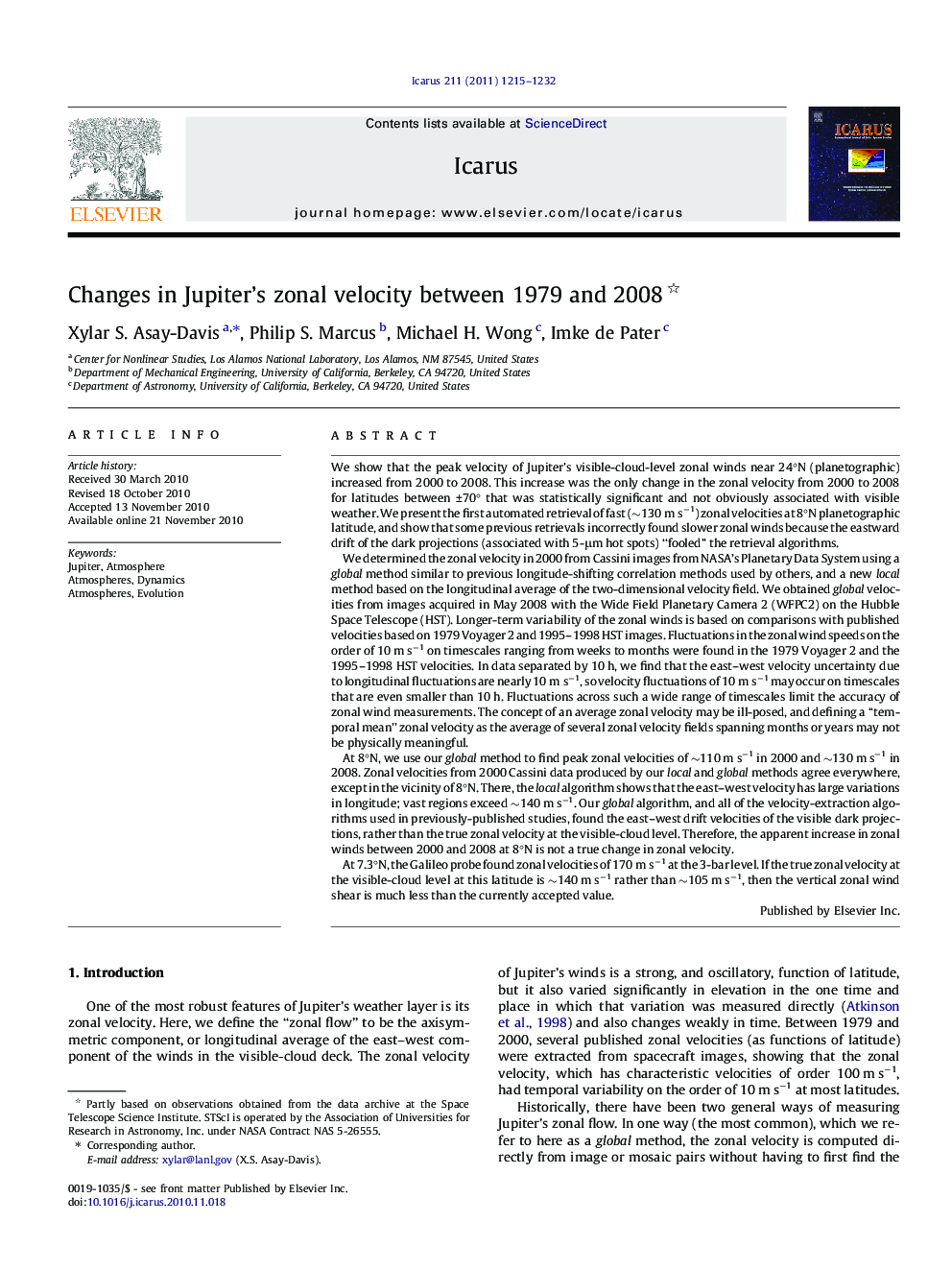| Article ID | Journal | Published Year | Pages | File Type |
|---|---|---|---|---|
| 1773951 | Icarus | 2011 | 18 Pages |
We show that the peak velocity of Jupiter’s visible-cloud-level zonal winds near 24°N (planetographic) increased from 2000 to 2008. This increase was the only change in the zonal velocity from 2000 to 2008 for latitudes between ±70° that was statistically significant and not obviously associated with visible weather. We present the first automated retrieval of fast (∼130 m s−1) zonal velocities at 8°N planetographic latitude, and show that some previous retrievals incorrectly found slower zonal winds because the eastward drift of the dark projections (associated with 5-μm hot spots) “fooled” the retrieval algorithms.We determined the zonal velocity in 2000 from Cassini images from NASA’s Planetary Data System using a global method similar to previous longitude-shifting correlation methods used by others, and a new local method based on the longitudinal average of the two-dimensional velocity field. We obtained global velocities from images acquired in May 2008 with the Wide Field Planetary Camera 2 (WFPC2) on the Hubble Space Telescope (HST). Longer-term variability of the zonal winds is based on comparisons with published velocities based on 1979 Voyager 2 and 1995–1998 HST images. Fluctuations in the zonal wind speeds on the order of 10 m s−1 on timescales ranging from weeks to months were found in the 1979 Voyager 2 and the 1995–1998 HST velocities. In data separated by 10 h, we find that the east–west velocity uncertainty due to longitudinal fluctuations are nearly 10 m s−1, so velocity fluctuations of 10 m s−1 may occur on timescales that are even smaller than 10 h. Fluctuations across such a wide range of timescales limit the accuracy of zonal wind measurements. The concept of an average zonal velocity may be ill-posed, and defining a “temporal mean” zonal velocity as the average of several zonal velocity fields spanning months or years may not be physically meaningful.At 8°N, we use our global method to find peak zonal velocities of ∼110 m s−1 in 2000 and ∼130 m s−1 in 2008. Zonal velocities from 2000 Cassini data produced by our local and global methods agree everywhere, except in the vicinity of 8°N. There, the local algorithm shows that the east–west velocity has large variations in longitude; vast regions exceed ∼140 m s−1. Our global algorithm, and all of the velocity-extraction algorithms used in previously-published studies, found the east–west drift velocities of the visible dark projections, rather than the true zonal velocity at the visible-cloud level. Therefore, the apparent increase in zonal winds between 2000 and 2008 at 8°N is not a true change in zonal velocity.At 7.3°N, the Galileo probe found zonal velocities of 170 m s−1 at the 3-bar level. If the true zonal velocity at the visible-cloud level at this latitude is ∼140 m s−1 rather than ∼105 m s−1, then the vertical zonal wind shear is much less than the currently accepted value.
Research highlights► We show that Jupiter’s peak zonal velocity near 24°N increased between 2000 and 2008. ► We see no other significant changes between ±70° latitude during this period. ► Zonal velocities fluctuate in longitude, and over hours to years, by ∼10 m s-1. ► Past zonal wind measurements were 20–30 m s-1 too low near 5-micron hot spots (8°N).
